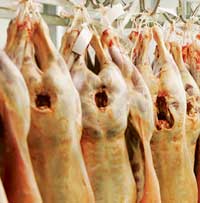Challenges and opportunities to developing lamb market

Lamb faces many challenges but great market opportunities too, producers were told at the EBLEX annual conference.
Declining lamb supplies in Europe offered opportunities to consolidate English exports, but it was crucial that a consistent product was supplied, said Chris Lloyd, industry development manager at EBLEX.
Just 57% of carcasses were in the fat and confirmation range where there was the best demand and premium prices. Against a background of domestic consumption and production both slowly declining, although lamb was considered tasty by 60% of consumers, it was also seen as expensive and often fatty (57%) compared to other foods.
Lambs’ versatility and nutrient value should be promoted to increase purchase frequency, said Mr Lloyd.
The challenges also included developing the fifth quarter market at home and overseas. Domestic offal consumption had already risen by 67% between 2003 and 2008 to £62m and a Meat and Livestock Commercial Services project in Scotland had turned a £2.2m disposal cost into an income of £13.3m.
Opportunities to develop products for the halal market were massive, with two million Muslims in the UK and six million non-Muslim halal consumers. “Muslim customers eat more lamb than the rest of us and are important to the cull ewe market,” said Mr Lloyd.
Technical challenges included reducing liver fluke losses and damage – 1,680,000 livers worth £1.5m were lost or damaged in 2009. More use of faecal egg counts could reduce treatments and costs, producers could also make better use of grass and take up genetic improvements, worth around £4 a lamb, more widely.
“The top 10% in 1990 wouldn’t even be in the bottom 10% today – the use of genetic is driving improvements in technical performance.”
Ram to ewe ratios could also be improved. “NZ rams probably serve double the number of ewes that ours do, it’s a target to aim for.” Despite higher ewes to ram ratios, NZ rams also lasted roughly a season longer than their UK counterparts.
There were also opportunities to supply the growing demand for locally sourced meat, establish fair supply contracts for producer groups or dedicated supply chains and to exploit technology to improve slaughter efficiency and meat quality, as well as ensuring the industry had new young skilled labour force for a sustainable future.
Climate change was a further challenge but one which brought economic benefits rather than restrictions, said Mr Lloyd. The CO2 equivalent cost of lamb production must be reduced by 11% by 2020 to meet government targets. This could be achieved through increased feed efficiency, improved fertility and increased longevity.
“It’s a win, win in all ways – reduce the CO2 and increase profitability,” he said.
